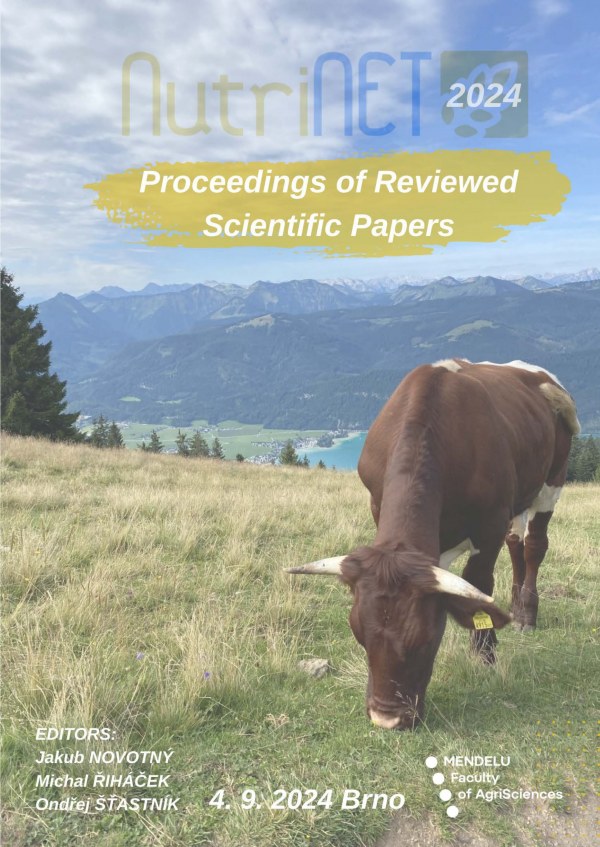
DOI: 10.11118/978-80-7509-994-5-0022
MELANIN IN BARLEY: FROM ISOLATION TO A POSSIBILITY TO INFLUENCE THE ACTIVITY OF BIOTRANSFORMATION ENZYMES
- V. BATKOVÁ1, L. JOUROVÁ1, Š. ŠATKA1, V. FRÝBORTOVÁ1, P. ANZENBACHER2, E. MRKVICOVÁ3, P. MARTÍNEK4, E. ANZENBACHEROVÁ1
- 1 Department of Medical Chemistry and Biochemistry Faculty of Medicine and Dentistry, Palacky University Olomouc, Czech Republic
- 2 Department of Pharmacology, Faculty of Medicine and Dentistry, Palacky University Olomouc, Czech Republic
- 3 Department of Animal Nutrition and Forage Production, Faculty of AgriSciences, Mendel University in Brno, Zemědělská 1, 613 00, Brno, Czech Republic
- 4 Agrotest fyto, Ltd., 76701 Kroměříž, Czech Republic
This study describes the isolation and characterization of melanin from plant matrices using a modified version of the alkaline extraction method originally described by Sava et al. (2001). Melanin was isolated from barley (variety Nudimelanocriton) and purified through a series of organic solvent treatments, acidic hydrolysis, and repeated precipitations, yielding approximately 5 mg of pure melanin from 12 g of barley grain. Isolated melanin exhibited its characteristic properties as insolubility in water, acids, and organic solvents, while being soluble in alkaline media and precipitable below pH 3. Consistent with findings from Caldas et al. (2020) and Glagoleva et Shoeva (2020), melanin samples exhibited in alkaline media a broad-band almost monotonous decrease of UV/VIS absorption from initially 200 nm, with unresolved absorption band at about 270 nm, indicative of complex conjugated structures of aromatic character. Additionally, effect of melanin on cytochrome P450 1A1/2 enzyme activity was assessed in HepG2 cells using 7-ethoxyresorufin O-dealkylation and high-performance liquid chromatography. Melanin at three concentrations (10 μg/mL, 1 μg/mL and 0.1 μg/mL) did not significantly induce cytochrome P450 1A1/2 enzyme activity (in contrast to CYP1A1/2 potent inducer, 2,3,7,8-tetrachlordibenzodioxin resulting in a nearly sixtyfold increase). These findings contribute to understanding the physicochemical properties of barley-derived melanin and its interaction with hepatic enzymes of xenobiotic biotransformation (as CYP1A1/2).
Keywords: melanin; allomelanin; barley; cytochrome P450; enzyme activity; cell culture; HepG2; UV-visible spectrophotometry
pages: 22-36, online: 2024
Correction:
On 9th September, page 35 was corrected. The last number was omitted from the number of project NAZV. The correct number is NAZV QL24010230.
References
- Anzenbacher, P., et Anzenbacherova, E. (2001). Cytochromes P450 and metabolism of xenobiotics. Cellular and Molecular Life Sciences CMLS, 58, 737-747.
 Go to original source...
Go to original source... - Bell, A.A. et Wheeler, Michael. (2003). Biosynthesis and Functions of Fungal Melanins. Annu. Rev. Phytopathol. 24. 411-451.
 Go to original source...
Go to original source... - Caldas, M., Santos, A. C., Veiga, F., Rebelo, R., Reis, R. L., & Correlo, V. M. (2020). Melanin nanoparticles as a promising tool for biomedical applications - a review. Acta biomaterialia, 105, 26-43.
 Go to original source...
Go to original source... - Chang, T. K., et Waxman, D. J. (2006). Enzymatic analysis of cDNAexpressed human CYP1A1, CYP1A2, and CYP1B1 with 7-ethoxyresorufin as substrate. Methods in molecular biology (Clifton, N.J.), 320, 85-90.
 Go to original source...
Go to original source... - Glagoleva, A. Y., Shoeva, O. Y., Khlestkina, E. K. (2020). Melanin Pigment in Plants: Current Knowledge and Future Perspectives.Frontiers in Plant Science, 11, 770.
 Go to original source...
Go to original source... - Guo, L., Li, W., Gu, Z., Wang, L., Guo, L., Ma, S., Li, C., Sun, J., Han, B., & Chang, J. (2023). Recent Advances and Progress on Melanin: From Source to Application. International journal of molecular sciences, 24(5), 4360.
 Go to original source...
Go to original source... - Hou, R., Liu, X., Xiang, K., Chen, L., Wu, X., Lin, W., Zheng, M., et Fu, J. (2019). Characterization of the physicochemical properties and extraction optimization of natural melanin from Inonotus hispidus mushroom. Food chemistry, 277, 533-542.
 Go to original source...
Go to original source... - Pearce, R. E., McIntyre, C. J., Madan, A., Sanzgiri, U., Draper, A. J., Bullock, P. L., Cook, D. C., Burton, L. A., Latham, J., Nevins, C., & Parkinson, A. (1996). Effects of freezing, thawing, and storing human liver microsomes on cytochrome P450 activity. Archives of biochemistry and biophysics, 331(2), 145-169.
 Go to original source...
Go to original source... - Pralea, I. E., Moldovan, R. C., Petrache, A. M., Ilieș, M., Hegheș, S. C., Ielciu, I., Nicoara, R., Moldovan, M., Ene, M., Radu, M., Uifalean, A., et Iuga, C. A. (2019). From Extraction to Advanced Analytical Methods: The Challenges of Melanin Analysis. International journal of molecular sciences, 20(16), 3943.
 Go to original source...
Go to original source... - Sava, V.M., Galkin, B., Hong, M., Yang, P., et Huang, G.S. (2001). A novel melanin-like pigment derived from black tea leaves with immuno-stimulating activity. Food Research International, 34, 337-343.
 Go to original source...
Go to original source... - Singla, S., Htut, K. Z., Zhu, R., Davis, A., Ma, J., Ni, Q. Z., Burkart, M. D., Maurer, C., Miyoshi, T., & Dhinojwala, A. (2021). Isolation and Characterization of Allomelanin from Pathogenic Black Knot Fungus-a Sustainable Source of Melanin. ACS omega, 6(51), 35514-35522.
 Go to original source...
Go to original source... - Solano, F. (2014). Melanins: Skin Pigments and Much More-Types, Structural Models, Biological Functions, and Formation Routes. New Journal of Science, 2014, 1-28.
 Go to original source...
Go to original source... - Varga, M., Berkesi, O., Darula, Z., May, N. V., et Palagyi, A. (2016). Structural characterization of allomelanin from black oat. Phytochemistry, 130, 313-320.
 Go to original source...
Go to original source... - Wakamatsu, K., et Ito, S. (2002). Advanced Chemical Methods in Melanin Determination. Pigment Cell Research, 15(3), 174-183.
 Go to original source...
Go to original source... - Wang, H., Pan, Y., Tang, X., et Huang, Z. (2006). Isolation and characterization of melanin from Osmanthus fragrans' seeds. LWT - Food Science and Technology, 39(5), 496-502.
 Go to original source...
Go to original source... - Zucca, F. A., Basso, E., Cupaioli, F. A., Ferrari, E., Sulzer, D., Casella, L., et Zecca, L. (2013). Neuromelanin of the Human SubstantiaNigra: An Update. Neurotoxicity Research, 25(1), 13-23.
 Go to original source...
Go to original source...


